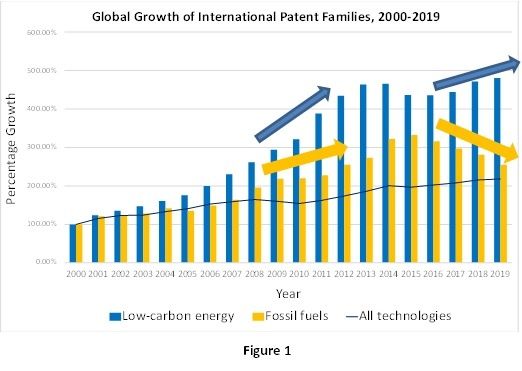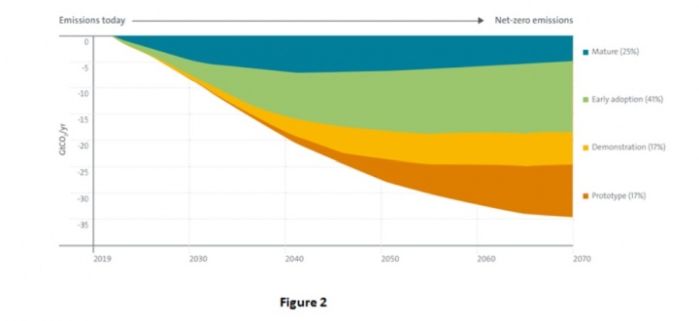The European Patent Office (EPO) and the International Energy Agency (IEA) have published a joint study about global trends in clean energy technology innovation. The report encompasses over 70 pages of data and graphs taken from the last two decades of innovation from the database of the EPO. Patent databases provide a wealth of information on trends in technology, including those directed to Climate Change Mitigation Technologies (CCMTs) and to the ongoing investment in such technologies. Here we examine and summarize some of the conclusions of the report.
The full report can be found here
A key observation from the study is an overall growth in International Patent Families relating to low-carbon energy (as seen in Figure 1), which is significantly greater than the growth across technology in general (which has doubled across all sectors in that period).
As crude oil prices rose from the turn of the century to a peak in 2014, so the data from this study reveals an increase in innovation across fossil fuels and low-carbon energy technologies. High energy prices create an incentive for extracting oil and for making more efficient use of both oil and alternative energy sources.

The data reveals a small slump in International Patent Families relating to low carbon energy from 2015-2017. There may be several factors accounting for this. It may represent a natural pause following a phase of rapid innovation, or it may simply reflect a one-off adjustment following a fall in the price of crude oil from about $120 per barrel in June 2014 to about $40 in February 2016.
The study uses an "International Patent Family" (IPF) as a unit of measurement. This is a set of patent applications for the same invention that includes a published international application under the PCT or a published application at a regional patent office (primarily the EPO) or published patent applications at two or more national offices. This is considered a fairly reliable measurement of inventive activity, as it is not unduly swamped by activity in any one patent office (such as China) and neither is it skewed towards inventions that are filed by multinational companies in many patent offices.
The date attributed to an IPF refers to the year of earliest publication within the family. This is generally 18 months after filing. So a dip in IPFs in 2015 and 2016 corresponds to a dip in innovation and new filings in the period from about mid-2013 to mid-2015 and/or a lack in secondary patent filing from about mid-2014, which is just about the time the oil price began its descent.
From about 2016, innovation in fossil fuels and low carbon
technologies can be seen to follow different trends. That year
represents a low point in crude oil prices and, of course, the
signing of the Paris Agreement.
Upon adopting the Paris Agreement, participating nations are
implementing policies to reduce carbon emissions, and it is
encouraging to see from this report that LCE technological
innovation is following suit.
Just for comparison, we can also see a steadily increasing rise in IPFs across all technologies in the period in question. Indeed, there is a doubling of general innovative activity by this measure.
Importance of early stage technology in meeting Net Zero Targets
Another trend highlighted by the report is the global sector CO2 emission reductions by current technology readiness category in the IEA Development Scenario relative to the Stated Policies Scenario (as shown in Figure 2).

The figure shows a trajectory for emissions that is consistent with reaching global "net-zero" target CO2 emissions by 2070 as set out by the United Nations Sustainability Development Agenda (in line with the Paris Agreement). Four different stages of technology readiness are included:
- Prototype
- Demonstration
- Early adoption and
- Mature
The Sustainable Development Scenario is used to illustrate the technology needs for reaching net-zero emissions from the energy sector. It describes the broad evolution of the energy sector that would be required to reach the United Nations Sustainable Development Goals (SDGs) most closely related to energy. The trajectory for energy-related and industry-related CO2 emissions in the Sustainable Development Scenario is consistent with reaching global net-zero CO2 emissions from the energy sector in 2070.
The Stated Policies Scenario is a benchmark that
assesses the evolution of the global energy system on the
assumption that government policies and commitments that have
already been adopted or announced are implemented. It includes
commitments made in the nationally determined contributions under
the Paris Agreement, such as the UK Government's commitment to
net-zero emissions by 2050.
The chart illustrates the technological shortfall in terms of CO2
reduction required to bring the cumulative government commitments
towards long term sustainable development.
The percentage beside each layer of the chart denotes the cumulative emissions reduction by 2070 that each respective stage of technology development needs to deliver.
Representing a quarter of the needed cumulative CO2 emissions reductions, the mature technology stage represents existing technologies that require additional uptake to reach a sustainable pathway. This category is important in reducing cumulative CO2 emissions.
The "early adoption" technology stage on the chart represents technology that is currently being invested in, to be deployed in the next decade or is already in the early stages of deployment. This is perhaps the most important current technological stage, because it represents 41% of needed cumulative CO2 emissions reductions. These technologies will have the largest impact upon reaching the sustainable development pathway by 2070.
The "demonstration" technology stage represents technology that has either been proposed or is under review. The "prototype" technology stage represents technology that is currently being designed, built, and tested. Together, these technological stages represent 34% of the needed cumulative CO2 emissions reductions. These technologies are predicted to make a significant contribution by 2050, the UK's "net zero" target date.
The data closely follows the expectation that the coming decade will be important for innovation in climate change mitigating technology. A further decade or more will be required for roll-out of new technologies on a scale that will achieve the government's net zero ambitions. If the innovation curve can be encouraged to follow a steeper initial trajectory, this early stage technology can make an even greater contribution to meeting net zero targets.
Where do patents come in?
We are sometimes asked "surely climate change mitigating technology should not be patented but should be free for the benefit of mankind?"
With a patent expiry date of 20 years after filing, all the vast expanse of technology invented in the 20th century is now in the public domain (with very few exceptions, mainly in the pharma industry)*.
All recently created technology will lose patent protection by about 2040 at the latest. It is increasingly difficult for mature technology to gain patent protection. Only incremental improvements can be protected. Patents create an incentive to invest in new technologies. Indeed, investors expect that patent applications will be filed for new technologies in which they invest. Patents give a time-limited period in which to recoup the up-front investment.
Conclusions
There is no doubt that this report shows an increase in low-carbon energy patent activity compared to all technologies and that there is a positive trend towards reducing CO2 emissions through technology. It is promising to see that patent activity relating to low carbon energy is supplanting patent activity relating to fossil fuels.
Two thirds of the cumulative CO2 emissions reductions needed to achieve sustainable development must be taken on by technology that is mature or is in the early adoption stage. To reach the UK goal of being net-zero by 2050 or the Paris Agreement goal of sustainable development by 2070, new technologies will be essential. The cycle to produce and advance new technologies must also be shortened.
In the '60s and '70s, there was enormous investment in a single transformative energy sector, i.e. nuclear. The investments envisaged in the forthcoming energy transformation are predicted to be similar in scale but spread across a far wider range of solutions. Patents will be vital in underpinning such investments.
*The maximum period is 21 years when taking advantage of the initial "priority" year, and the average lifetime of a patent is rather shorter – typically 13 years – because renewal fees are not always paid for the full patent term. Other forms of protection such as registered designs and utility models have different terms.
Originally published 27 September 2021
The content of this article is intended to provide a general guide to the subject matter. Specialist advice should be sought about your specific circumstances.


